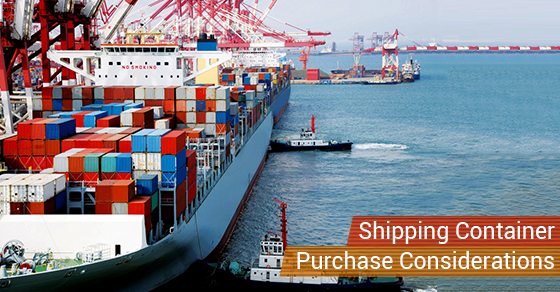
When you are out of space to keep your inventory, business records, or some other business or personal need, shipping containers can be your best option.
Containers are versatile vessels that can be easily converted into a form that fulfils your need: home, guesthouse, shed, shelter, garage, office, and a lot more. Buying a container, as opposed to renting means that you can do whatever you want with it. However, this is also a costly option, so it is important that you make the right choice the first time.
Here are some things to consider before purchasing a shipping container:
- Space for the container to sit
Standard containers measure 8 feet wide, 8.6 feet tall, and either 40 or 20 inches in length. So, you need to have enough ground space measuring 8 x 20 feet or 8 x 40 feet, and the height should not obstruct your view of anything important. Additionally, you require about 110 to 120 feet of straight clearance (including the site) to get the container trucked in.
- Size of the container
Whether you choose the bigger or smaller size depends on your needs. The 20-foot container can hold furnishings of a 3-bedroom home, while a 40-foot container can hold approximately 24 3-foot wide pallets. The 40-foot container gives a better value for your money. However, if you intend to move the container around, the 20-foot one is more portable.
- Quality of the container
There are few qualities to choose from:
- New or one-trip containers – They are manufactured in Asia and shipped overseas for sale. They are usually green, tan, or grey, and are rust and dent-free.
- Cargo worthy containers – These are the best-quality used containers, and are certified as structurally sound for shipping. They may have some dents, rust, and shipping markings.
- Wind and watertight containers – They are good, solid containers, but their cargo-worthy certification may have expired. They may also have a defect that does not necessarily affect storage performance.
- As-is containers – They have known problems, such as bad floors, damaged roof, or holes, and come with no warranties from vendors.
- How the container will be delivered
If you have a crane, forklift, or backhoe to offload the container yourself, you can save on delivery costs. However, manufacturers usually handle the transport from the nearest empty container location to your destination.
- Security
Containers are fabricated from Corten steel, which makes them impenetrable. The doors have levers, so you can secure them easily with a good padlock. You may need to add a metal lockbox to safeguard the padlock if the container will be kept at a remote or unmonitored site.
- Modifications
Depending on what you plan to use the container for, you may need to add an extra door (roll-up or man-door), a window, or some vents, all of which are fairly easy to do especially if you have a weld kit.
- Upkeep and maintenance
Although Corten (weatherised) steel inhibits rust, steel is still prone to rust. This is noticeable in used containers. Fortunately, a fresh coat of paint should conceal any signs of wear.
Lastly, you need to consider the cost. The cost usually includes the quality of the container, the pick-up point (cheaper on the coast than inland), and delivery charges (cheaper for short travel distances). So, compare the quotes for these three aspects when shopping vendors.

It’s interesting that you should consider what size of container that you will actually need. It would be nice to see all of the things that you need to put in it, and then figure out how much size will be needed. Plus, you might be able to find something cheap because of the size.